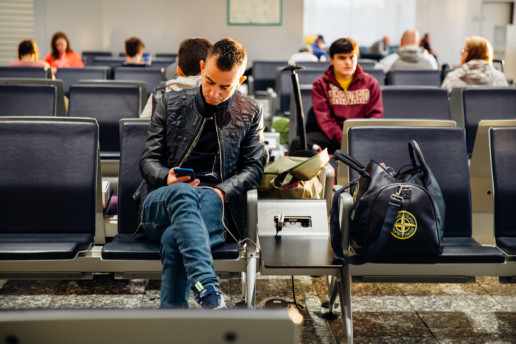COVID-19 will disrupt many established workplace trends
Over the past few months, the coronavirus pandemic has altered almost every aspect of how people around the world live their lives and do their jobs. In the months to come, it will continue to disrupt and transform routines. Sooner or later, though, the emergency will end. Lots of things will go back to the way they were before January 2020. Some won’t.
So much has already been written and said about the latter group of possibilities that I hesitate to add to the cacophony. But it may lend some structure to the discussion to sort the changes to come into three broad categories.
The first involves pre-existing trends that are being accelerated by the pandemic. The second involves trends that have been reversed by the pandemic. Then there’s … everything else.
Perhaps the most obvious case of a trend being accelerated by the pandemic is working from home. Doing so was actually more common back when tens of millions of Americans still lived on farms, shopkeepers lived above their stores and women sewed garments at home for piecework rates. But since 2000, which is around when broadband internet access began to become widely available, white-collar workers have driven a rise in the percentage of American workers who say they usually do their jobs from home, from 3.3% to 5.3%.
The percentage is a lot higher than that right now! Only 29% of employed Americans said they could work from home in a 2017-2018 Bureau of Labor Statistics survey. But given that those who can’t work remotely have been laid off or furloughed in huge numbers since March, nearly half of those who now have jobs in the U.S. have likely been doing them from home, estimates Adam Ozimek of the online labor marketplace Upwork.
My guess is that many of these people will be eager to return to the office when the pandemic is over. But large office buildings may not go back to full-scale operation for quite a while, and by the time they do many employers will have rethought their office-space needs, many workers will have rethought their commutes and many organizations small and large will have discovered new ways to collaborate from afar, with all sorts of consequences for office dynamics, business travel, commercial real estate and maybe even the shape of urban growth.
This growing freedom to work from somewhere other than the office will be empowering and liberating for some. But working remotely is for the most part a privilege of the affluent and educated, and some of the other trends getting a boost from COVID-19 don’t seem all that favorable for workers. For example, industry after industry in the U.S. has been growing more concentrated since 2000, and new-business formation has been on the decline a lot longer than that.
Yes, young companies gained a little ground in 2015 and 2016. But a new data series from the Census Bureau indicates that the formation of new businesses with hiring plans is down 32% since mid-March versus the same period last year, so that resurgence is over for now. Any economic downturn is going to favor strong companies over weak ones, but the particulars of this one seem to favor the giants even more than usual. Big tech companies are strengthening their grip as the pandemic progresses, and the fact that the five biggest such companies in the U.S. — Microsoft, Apple, Amazon.com, Alphabet and Facebook — account for more than 20% of the value of the Standard & Poor’s 500 Index and nearly 50% of the Nasdaq Composite Index explains a lot about the resilience of the stock market amid economic calamity. Buyout firms that target troubled companies have also been seeing big stock-market gains. Consolidation is accelerating, and while conditions for those employed by giant, profitable companies in technology and some other sectors can be pretty great, the overall bargaining power of workers suffers.
Another workplace trend of long standing is increased automation. Fears of a rapid, massive displacement of humans by robots haven’t yet been realized, but machines have been taking over human tasks for centuries, and the pandemic seems likely to accelerate this process, especially for jobs that involve people performing physical labor in close proximity to one another — from meatpacking plants to Amazon warehouses to, perhaps, commercial kitchens. The need for distancing will eventually abate, but once companies invest in machines that do some or all of the work, those machines are unlikely to go away. There’s also been a rush to enlist 3-D printers to solve temporary supply-chain problems that will likely lead to their permanent, often-labor-replacing use. Such innovations can drive the productivity growth that improves living standards, not to mention displace jobs that are objectively awful, so this isn’t all bad news. But short-term it again reduces workers’ bargaining power.
So much for trends that are being accelerated. The most dramatic reversal so far has been the end to the long rise of employment in leisure and hospitality. The sector, which includes restaurants, hotels, casinos, museums, gyms, sports teams and, of course, bowling alleys, accounted for almost a quarter of U.S. payroll job growth over the course of the just-ended expansion — and lost almost half of its jobs between March and April.
The damage to the industry is severe and will persist for quite a while. If government efforts to keep these businesses on life support falter, it could take many years to repair. But once the threat of the coronavirus has passed, or receded into the background of seasonal respiratory ailments, almost everyone is going to want to hang out with friends, go to restaurants, sports events and shows, and travel again. The upward trend will surely resume; the big question is just where the starting point will be.
A lot of the biggest questions about the post-coronavirus work environment will be answered by political action or the lack thereof. Will the failures of the mostly job-based U.S. health-insurance system in a job-destroying pandemic lead to major reforms? Will the greater toll the pandemic has exacted on the disadvantaged encourage efforts to reduce economic inequality? Will the safety net be reformed to address the effects of automation? Will renewed antitrust enforcement counter the trend toward consolidation? Or do I have the direction of change all wrong here, and what we should really expect is more government dysfunction and maybe some tax cuts? I DON’T KNOW! And nobody else does, either. Predicting what might happen seems far less useful than working to bring about the change you want to see.
SOURCE: Fox, J. (15 May 2020) "COVID-19 will disrupt many established workplace trends" (Web Blog Post). Retrieved from https://www.employeebenefitadviser.com/articles/covid-19-wont-change-everything-for-workers-right
Virus impact may extend to 57 million U.S. jobs
Did you know: the coronavirus pandemic has caused more than 26 million employees to file for unemployment. As the coronavirus continues to spread, many employees are still at a loss for jobs. Read this blog post to learn more.
The coronavirus pandemic will hurt 57 million U.S. workers, more than double the number of jobless claims so far, once furloughs and reduced hours and pay are included, according to McKinsey.
The more than 26 million people who have filed unemployment claims in the past five weeks provide only a partial picture of workforce dislocations, with tens of millions more facing additional risks, according to a report by economists including Susan Lund at the McKinsey Global Institute, the think tank arm of the consultancy.
The earliest wave of unemployment claims in mid-March disproportionately hit the food service, entertainment and hotel industries. The disruption has since moved into categories including retail, business services, manufacturing and non-essential health care.
There’s significant overlap between workers who are vulnerable because of the virus and those whose jobs were already at risk from automation, providing a challenge for the U.S. to train at-risk employees for more sustainable job opportunities.
Low-wage, part-time and minority workers are the most likely to be hurt by the pandemic, with 74% of at-risk jobs paying less than $40,000 a year, according to McKinsey’s analysis. But the number of full-time and white-collar positions being affected is rising, with 16% of vulnerable workers making more than $70,000 a year.
“It’s really the people who are generally lowest paid, less educated and least prepared to weather a spell of unemployment that are most at risk,” Lund said in a phone interview.
Education is the strongest demographic predictor of vulnerability, with people who don’t have bachelor’s degrees twice as likely to hold such jobs.
Companies can help by reducing hours and temporarily furloughing workers rather than firing them, McKinsey said. They also should offer greater flexibility to parents working from home and find ways to reconfigure office spaces to prevent a new virus outbreak. State workforce agencies can help provide training and education opportunities for the unemployed, McKinsey said.
SOURCE: Martin, E. (01 May 2020) "Virus impact may extend to 57 million U.S. jobs" (Web Blog Post). Retrieved from https://www.employeebenefitadviser.com/articles/virus-impact-may-extend-to-57-million-u-s-jobs
How Managers Are Handling Performance Reviews During COVID-19
With many employees working from home during this coronavirus pandemic, many HR managers are facing unknown challenges in supervising employees and implementing performance reviews from afar. Read this blog post from SHRM to learn more.
As millions of Americans work remotely during the coronavirus pandemic, managers unaccustomed to supervising employees from afar face challenges in evaluating performance and providing good feedback.
"Most of the components of our performance reviews have been discarded during the coronavirus crisis," said Mike Falahee, chief executive officer at Marygrove Awning Co. in Livonia, Mich. "After all, how can we review someone who can't do their job the way they're accustomed to doing it?"
Shifting Tactics
No doubt, many company leaders share that sentiment as the world of work has changed swiftly in the past eight weeks. In that time, many companies have shifted to remote-only operations.
According to a Gallup survey, the percentage of workers who say their employer offered them flextime or remote-work options grew from 39 percent in mid-March to 57 percent by early April.
Additionally, 62 percent of employed Americans say they've "worked from home during the crisis, a number that has doubled since mid-March," according to Gallup.
Company leaders and managers say several strategies—some that were in place before the virus, some that are new—have helped them measure workforce production in the age of COVID-19.
Kerry Norman is vice president of talent solutions at CHG Software in Salt Lake City. Several years ago, CHG decided to ditch its traditional annual performance reviews for front-line employees.
"We found that it was ineffective for several reasons," Norman said. "First, it was a look backward, so it didn't help improve future performance. Second, it wasn't an effective measurement tool because assessments varied so greatly from one leader to the next. Third, it was disengaging for employees. It felt more like a judgment than a motivational tool."
Now the company focuses on providing "in-the-moment" feedback, and that has proved helpful during the virus.
"We want people to know what they're doing right and where they can improve, rather than waiting until the end of the year when it's too late to do anything about it," Norman said.
Shifting Roles
The pandemic is also forcing everyone at CHG, managers as well as their staff, to be more flexible. That means employees are taking on new roles, some for which they've never been trained. And managers must show flexibility when evaluating these workers, allowing time for a learning curve and understanding that there will be hiccups.
"Our people are now learning their skills can be used in ways they never knew existed, and they're helping in areas of the company that may have been foreign to them just weeks ago," Norman said.
Andres Lares is a managing partner at Shapiro Negotiations Institute in Baltimore. Before the virus hit, the company conducted formal reviews once a year. Now, Lares said, his firm's managers check in with workers weekly.
Moreover, his firm's managers have, for now, stopped evaluating employees based on the revenue they generate. Instead, he said, "we want to see our marketing team reach out to more people than ever via phone or e-mail during this time. In doing so, we're not emphasizing sales and revenue in the short term, but we are tracking demonstrated thought leadership from our employees that leads to more sales" in the future.
Adem Selita is chief executive officer at the Debt Relief Co. in New York City, which already had an automated performance system that tracked employees' metrics by the day, week, month and year.
With COVID-19 shaking up the company's office culture, that system has changed. These days, each performance review is scheduled more than a week in advance and employees are sent a template to fill out with instructions. Employees send back their responses for the manager to look over and use as a guide during the review.
"While time is still spent on going over output, the emphasis now is on what the employee needs help with, what they'd like to work on, ultimately with three takeaways the employee will focus on and discuss in the next review with their manager," Selita said.
Communication Challenges
Following this new performance review blueprint hasn't been easy during the pandemic.
"The biggest setback at first was communications," he said. "We're moving from a management culture where leaders are steps away from an employee's desk to a scenario where leadership isn't physically present. That leads to many questions not being asked [by the manager or employee] until it comes time for performance reviews."
On the upside, managers have noted new opportunities to discuss performance more broadly.
"With traditional performance reviews, employees were using much of their allotted time discussing small-ticket items, leaving them with little time to focus on development and what they can do better," Selita said. "By establishing more regular check-ins, we've found that employees are leaving sessions feeling more capable and motivated than ever."
Ken Eulo is a founding partner at Smith & Eulo Law Firm in Orlando, Fla. His firm has decided to push back performance reviews entirely during the coronavirus crisis.
"We believe it's unfair to hold employees to the same standards during this outbreak," he said. "The economy is suffering, and we are offering limited services as a firm. Consequently, we have completely halted performance reviews for the time being, as we can't find reasonable parameters to measure each employee's performance due to the circumstances."
Eulo said his firm will resume performance reviews when its services return to normal.
"For the time being, we are trusting employees to hold themselves accountable," he said.
SOURCE: O'Connell, B. (28 April 2020) "How Managers Are Handling Performance Reviews During COVID-19" (Web Blog Post). Retrieved from https://www.shrm.org/resourcesandtools/hr-topics/people-managers/pages/performance-reviews-during-coronavirus-.aspx
The Performance Review Process Can Be a Lot Easier. Here’s How.
The annual performance review has long been a fraught ritual that both managers and employees dread. Now that it's evolved, in many companies, into a less formal, yearlong process often called a "continual conversation," managers face new challenges.
Perhaps most notably, managers are now saddled with more work: conducting check-ins with multiple employees twice a month, holding quarterly meetings that can include feedback from colleagues and subordinates, writing detailed reports, and analyzing feedback surveys. The annual meeting about salary and bonuses remains on the docket as well.
"It can be a big problem," said Brian Kropp, a human resources expert at the Gartner Group, a Connecticut-based research and advisory company. "Managers spend an average of 210 hours per year on performance management, and our data shows their No. 1 frustration with the process is how time-consuming it is."
Experts say there are several ways to make this new era of performance reviews less cumbersome. For example, managers should get employees more invested in the process by having them do the bulk of the prep work for the check-ins and meetings. Managers should also act more like coaches and make the frequent sessions less formal, with an emphasis on keeping them collaborative. And they should use feedback technology to automate more parts of the process.
As far as workload goes, "you don't have to take all that responsibility on yourself," said Dick Grote, a Texas-based management consultant who has worked at General Electric, United Airlines and Frito-Lay. "Put that work on the employee."
Give employees standard templates and frameworks with directed questions to answer. These questions can include "What are my priorities right now?," "What obstacles am I running into?" and "What feedback have I received?"
Managers can also change the dynamic that is typically associated with the process. BJ Gallagher, a Los Angeles-based workplace consultant who has worked with IBM, John Deere and Chrysler, has seen many performance evaluations get bogged down by a judgmental and adversarial interaction. She said managers can improve employee performance more effectively and efficiently by using a collaborative approach, and that can start with the initial conversation in the yearlong check-in process. "The start of the year is when mutual goals can be established as a manager-employee team looking together at the big projects on the horizon," she said. "Use that check-in session to establish three to five goals and stay away from subjective behavioral goals. Make them measurable."
To that end, managers should approach the process like "a great coach, not a traditional boss," said Ben Wigert, director of research and strategy in the workplace management division of Gallup. "It's about changing their lens and thinking about what a great coach looks like."
Studies show that employee performance improves when managers give workers meaningful feedback and make the conversations more team-oriented. For instance, managers can get an employee's peers to give feedback. Peer input can help reduce some of the burden on the manager and emphasize the team aspect of the process.
But Kropp pointed out that there is a downside to peer feedback: It can be vulnerable to bias, especially when the input is given in an "open box" format. "We suggest organizations direct peer feedback with targeted questions about specific actions and outcomes," he said.
Another tool to make the process more manageable is feedback technology. For instance, a manager can formally capture all performance conversations and feedback in the organization's human capital management system, Kropp said.
Ultimately, revamping the process from an annual review to a yearlong conversation should lead to less work for managers, not more, consultants said.
SOURCE: Rosenkrantz, H. (28 April 2020) "The Performance Review Process Can Be a Lot Easier. Here’s How." (Web Blog Post). Retrieved from https://www.shrm.org/resourcesandtools/hr-topics/people-managers/pages/ongoing-performance-reviews-.aspx
Viewpoint: How to Lead in a Crisis
As many leaders have been faced with uncertainty during the trying times the coronavirus pandemic brought upon them, it's important for them to lead with the advantage that the uncertainty can bring. Read this blog post to learn more.
Despite a host of warnings about the impending COVID-19 crisis, it caught most of us by surprise. I recall attending the regular leadership team meetings of a few of my clients the week of March 9, and by March 15, the world had changed. It was no longer a potential crisis; it was a full-on global pandemic where new terms such as "social distancing" and "flattening the curve" became part of our lexicon. A spectrum of responses emerged, from reactive chaos to deploying well-practiced business continuity modes.
The challenge that leaders face in a crisis is that their organizations aren't typically set up to operate with such uncertainty. Leaders create visions, plans and metrics to attempt to control their environments and minimize uncertainty as best they can. In a crisis many leaders default to what they know how to do in order to reduce frustration and quell their own and others' fears. This default mode is simply not productive and rather than reduce uncertainty and anxiety, it increases both.
Today all organizations are faced with a new normal—uncertainty and inability to control the environments in which they operate. We know the pandemic will end but it won't truly be over until a vaccine is available. We know the curve will eventually flatten but projections seem to change hourly. We know people will get back to work but we don't know whether social distancing will continue to influence the economy. We know that remote work is possible on a broad scale but it's not clear if this will work long-term.
Ralph Stacey and Douglas Griffin's definition of a leader is one that lends itself to today's environment: "One recognized as a leader has a greater capacity to live with the anxiety of not knowing and not being in control. The leader is recognized as having the courage to carry on interacting productively and creatively despite not knowing." This definition certainly applies to today's environment of tremendous uncertainty and great anxiety. Clearly there is much we don't know about what the future will hold. It is also clear that leadership today requires an ability to embrace uncertainty and interact productively.
While it's a relatively small sample size, we have been amazed by the approaches our clients have taken to navigate their way through these challenging times. None have had an easy time, and some were certainly more prepared than others, but most have quickly overcome their natural tendency to control and shifted to doing their best to operate in crisis mode. In each case a few important themes emerged for how to embrace the uncertainty – humility, transparency, engagement, focus and patience.
Positive humility. In their own ways, each CEO acknowledged their fear about the unknown and that they didn't have all the answers, but they exuded a sense of calmness and confidence in their organizations to work smart and hard to get through the crisis. By reinforcing and modeling positive humility CEOs have established a tone for their leadership teams to cascade throughout their organizations.
Transparency. CEOs and their leadership teams are proactively communicating difficult information openly and being clear when they don't have answers to important questions. For example, they are not promising that no jobs will be lost but they are committing to pursuing all avenues necessary such as the SBA CARES Loans to secure jobs as long as possible.
Engagement. When in doubt these organizations are doing their best to negotiate clear expectations (i.e., daily check-in sessions with supervisors) and over-communicate (i.e., using email, internal web site and supervisors to reinforce that hourly workers will be paid weekly). They are also encouraging managers and staff to use multiple channels to remain in contact both formally and informally (i.e., Virtual Team Meetings, Virtual happy hours, random watercooler calls).
Focus. After a short period of getting their remote offices working, CEOs and their leadership teams redoubled their efforts to ensure their organizations remained focused on the core mission (i.e., executing loans, building interiors, registering / renewing members). They also reinforced that today's plans would likely change tomorrow and that learning from mistakes and helping employees and customers manage uncertainty is a big part of their jobs.
Patience. In a crisis adults often revert to overdone strengths – people who are naturally decisive might become arrogant or people who tend to be naturally empathetic might become overly protective. These CEOs and their leadership teams recognize this tendency to revert. They are working hard to have patience with each other by giving space, not overreacting themselves and providing gentle feedback.
These are extremely challenging times and despite efforts by the smartest scientists, economists and business leaders in the world, there is no clear path to when things will get back to normal. Ambiguity is a daily obstacle for most business leaders, but today we are dealing with ambiguity on steroids. It is not easy but we are so encouraged to see so many CEOs and their leadership teams embrace the ambiguity to help their organizations get to the other side of this crazy time.
Jack McGuinness is co-founder and managing partner of Relationship Impact, a consulting firm focused on helping great leaders build great leadership teams.
This article is excerpted from www.ChiefExecutive.net with permission from Chief Executive. C 2020. All rights reserved.
SOURCE: McGuinness, J. (20 April 2020) "Viewpoint: How to Lead in a Crisis" (Web Blog Post). Retrieved from https://www.shrm.org/ResourcesAndTools/hr-topics/employee-relations/Pages/Viewpoint-How-to-Lead-in-a-Crisis-Coronavirus.aspx
Strategies for making layoffs a last resort during a crisis
Did you know: 6.6 million Americans have applied for unemployment due to the coronavirus pandemic. Many businesses are looking for other alternatives than automatically laying off their employees. Read this blog post to learn more.
In uncertain times business leaders can be faced with an impossible choice, keep every employee or keep their business afloat.
More than 6.6 million Americans have applied for unemployment, according to the Labor Department and there have been over 10 million jobless claims, as a result of the coronavirus pandemic keeping people in their homes and out of work. It is likely that businesses will make further cuts as the latest PwC survey suggests 44% of CFOs expect furloughs and 16% expect layoffs.
The unfortunate reality for many small businesses is that there typically isn’t an alternative to layoffs, but larger organizations have more options.
“There are several firms in the U.S. right now, including our own, that have publicly said layoffs are a last resort,” says Bhushan Sethi, PwC’s global people and organization leader. “What they are looking to do is be creative with the different levers you can pull around the workforce.”
Sethi in a recent interview shared ways in which employers can make layoffs a last resort in times of unpredictability.
How can businesses avoid layoffs during a crisis?
There’s looking at compressed work schedules, reducing costs in other areas, including real estate or business travel. There are other benefits employers may be offering that are not relevant like a car allowance or a travel allowance. Even before COVID-19 we’ve seen clients take a look at a compressed work schedule. Employers need to understand what it means if they offer a compressed work week, whether it is 40 hours across four days or in some areas it might mean one week on, one week off. So the compressed work weeks can take on different forms. Changing the pay would be next, and looking at the areas of your firm that have significant costs and looking at where value is created. What that could mean is changing the mix of pay at the executive level. Certain companies have come out and froze or capped executive pay or said executives won’t take bonuses. So there’s different levers on the compressed work schedules and on the pay models and then there are other kinds of cost control measures you can take.
How are employers designing benefits during this time?
In our CFO survey we saw that 56% of them were also looking at other benefits, specifically things like paid time off and sick leave. A number of them are saying “how do I design benefits around what my people want?” At PwC we said we’re going to give an emergency child care allowance to people who need it for $2,200. We’re seeing this shift around what you can offer your employees from a benefits perspective that might be very relevant to them. I’ve seen other clients say “well if there is a small piece of equipment that will help you with remote working like investing in a different shaped chair or something like that,” it seems trivial but it's really important to people’s experience right now.
How can employers reassure their remaining staff when they have to make staffing cuts?
It’s still an opportunity for firms to start planning beyond just today’s business. You’ve got to project out maybe 12 months and say what will my revenue and my profitability be, based on some assumptions being made around the business. The more you can get employers to actually think about kind of financial impact then you can walk it back and say okay, I‘ve got to ask about the costs I need to manage and how can I be creative by not just looking at payroll and salary and benefits, but how can I think about other levers I can pull? Can I offer sabbaticals to people? Can I do compressed schedules? Can there be job sharing in certain key rolls? Looking at all the different levers around it is going to be important because then you may actually get to a decision that is more beneficial for your employees, for society, and your business because you won’t be in the process of having to lay off a significant amount of people and cause reputational damage to the business.
SOURCE; Shiavo, A. (13 April 2020) "Strategies for making layoffs a last resort during a crisis" (Web Blog Post). Retrieved from https://www.employeebenefitadviser.com/news/strategies-for-making-layoffs-a-last-resort-during-a-crisis
Virtual Presentations, Meetings Require New Approaches for Success
While working remotely has become the new norm for many employers and employees, it's important to keep a strong communication base, especially with team meetings and presentations. Read this blog post from SHRM on various strategies to succeed in leading online meetings.
As more people work from home, many are being asked to take on tasks and use technologies with which they have only a passing familiarity, such as leading team meetings and presenting online rather than in person.
SHRM Online spoke with experts about the different strategies required to succeed in those scenarios, as well as how to use the features embedded in videoconferencing and Web conferencing platforms.
Presenting Online
Giving presentations online rather than in person requires thinking about how to design PowerPoint slides, keep remote audiences engaged when they're facing more distractions and troubleshoot technology snafus that arise in these situations.
Pick up the pace. Attention spans dwindle during virtual presentations. "That doesn't mean you need to cut the amount of your presentation content, but rather that you spread it over more slides so there is more frequent on-screen change for audiences," said Roger Courville, a Portland, Ore.-based speaker and trainer who teaches people how to communicate online and is the author of The Virtual Presenter's Handbook (CreateSpace Independent Publishing Platform, 2009).
Be proactive in guiding audience attention. Presenters should assume that some people are multitasking during an online presentation, Courville said. "You have to ask what the audience is taking away if at times they only glance at what you're presenting," he said. "One thing you can do is make sure the titles on your slides are more descriptive and capture the main point of the slide."
Virtual presenters also should use their voices to guide viewer attention, said Andrew Dlugan, a communications and presentation skills trainer in Vancouver, British Columbia, Canada.
Don't rely only on slide pointers or annotation tools provided on Web conferencing platforms.
"What happens if some people aren't looking at their screens for a while?" he said. "A presenter might say something like 'What do you see below the picture of the woman on this slide?' or 'Look at the data on the right-hand portion of your slide.' "
Courville said presenters should monitor audience attention levels by checking whether people are actively participating on chat features or submitting questions during a moderated Q&A. Some Web conferencing platforms also have a feature called an attention indicator that detects the active application on audience members' screens. If a conference participant has switched to checking e-mail, for example, that tool would register the change. Courville said that while the tool shouldn't be used punitively, it can help presenters get a read on when attendees may be drifting away so they can switch tactics, such as by introducing an audience poll or a short Q&A.
Unnecessary flair can cause technical problems. The use of animation and complex transitions on slides might work well in person, but they can cause problems online, said Bethany Auck, founder and creative director of SlideRabbit, a presentation design and production company in Denver.
Web conferencing platforms handle slide upload and display differently, and experts say it's best to go simple when designing slides, keep file sizes low, and avoid the use of animations or complicated transition techniques between slides.
Consider slide contrast issues and viewer screen size. Assume that many will be viewing your online presentation from smaller laptop screens or even on mobile devices, said Ken Molay, president of Webinar Success, a Web conferencing training and consulting company in Cary, N.C. "Design your slides as if you're creating them for viewers in the back of a large auditorium," Molay said. "Use larger fonts and plenty of white space, and don't put things near the edges of your slides."
Keep in mind that you won't be able to see how your slides display on your audience's screens, and your viewers' computer settings for contrast, brightness and color may vary widely. "Remember that light colors can easily wash out online. Stick with high-contrast color designs, and avoid using subtle tone variations that can be difficult for virtual audiences to see," Molay said.
Leading Small-Group Virtual Meetings
Many of us have been conditioned to hold hourlong meetings, but experts say that standard should be reconsidered with today's new reality.
"One of the most powerful tools built into videoconferencing solutions is the instant meeting," Courville said. "You can easily set up virtual meetings and collaboration sessions in short blocks of time as needed. There are product development teams I know who hold 15-minute videoconferences every morning. The medium can be used as flexibly as a phone call."
Leaders, mute yourself when others are speaking. "Many of us use words like 'OK' or 'uh-huh' as confirmation that we're listening when others are speaking," Molay said. "But in an online meeting, especially if you're the leader or a person of higher authority, others often hear that and they stop talking, wondering if you wanted to interrupt to say something or even that they might have said something wrong. If you stay completely silent, it lets people complete their thoughts."
Not all technology platforms are created alike. If you haven't yet purchased a videoconferencing or Web conferencing platform (most major providers are offering discounts or free trial versions of products during the coronavirus outbreak), Molay said it's important to understand the differences between systems.
For example, the videoconferencing platform Zoom is among those that Molay said have a useful "push to talk" feature that is handy for small-group virtual meetings.
"Everyone enters the meeting in a default mute mode, but when they hold down the space bar, it opens up their microphone," he said. "It only stays open while it's pressed and people are speaking, like the old walkie-talkie."
Molay said the feature is good for group discussions in which everyone wants a chance to participate but a leader doesn't want all microphones open at once, since they're likely to pick up background noise when participants work from home.
You also may want to compare audience polling tools in different systems, Molay said. "Some only allow for a few response choices, while others offer more," he said. Many users will also likely want a polling feature that allows participants to select the best answer rather than all that apply, he said.
Question management tools—a helpful feature for more-structured and moderated Web conferences—also can vary by platform. These tools give session leaders a way to prioritize audience questions.
"If you have 100 people in a Web conference, you'll want a way to mark that certain questions might be a high priority to address on air versus a lower priority that you can follow up on later," Molay said. "Some platforms are better than others in how they allow you to reorder and organize questions."
He added that other key system features to evaluate are the number of participants allowed on video calls, ability to automatically record Web conferences for later viewing, and tools that allow you to easily edit recordings or create transcripts of online meetings.
Watch how you position yourself on webcam. Don't position yourself in front of bright windows, which will place you in shadows. Raise your laptop so the camera is at eye level or higher.
"Laptop webcams are sitting lower and often shoot straight up into your nostrils," Molay said. "That's not the best look for most people."
Troubleshooting Technical Problems
People will inevitably experience problems with video, audio transmission or other functions in virtual settings. "The first thing to do is isolate whether it's just that person having the issue or everyone," Courville said. "In most cases it's just one person, but you usually don't want to stop the whole meeting or presentation just because one person is having a problem."
Molay said leaders can afford to spend only a limited amount of time trying to fix an individual's issues. "It's easy to focus on squeaky wheels in online settings, but you don't want to slow down 30 people to satisfy one person."
Meeting leaders also can mute and unmute participants on most platforms if people are having technical issues and bothering others, Courville said.
Auck, SlideRabbit's founder, said one tactic she uses when leading virtual presentations or workshops is to keep a second computer in view and log in as an attendee. "It won't account for all of the variables of people logging in remotely, but you'll have a tighter view of any lag in how your slides are advancing for viewers," she said.
Mike Fasciani, senior research director at research and advisory firm Gartner, said employees who reside in bandwidth-challenged areas can take steps such as turning off video and joining meetings using dial-in audio options while still seeing the content that's being shared through a browser.
Remote workers also can use their 4G-enabled smartphones rather than laptops or desktops in virtual meetings, he said. "Many video-meeting and workstream collaboration applications were built with a mobile-first design intent and so work as well as, if not better than, the desktop and Web client access," he said.
SOURCE: Zielinski, D. (30 March 2020) "Virtual Presentations, Meetings Require New Approaches for Success" (Web Blog Post). Retrieved from https://www.shrm.org/resourcesandtools/hr-topics/technology/pages/virtual-presentations-meetings-require-new-approaches.aspx
Early-Career Employees Face the Pandemic
Although working remotely can sound enticing, it can also create an over-abundance of stress for those who are not prepared. Many employees have had to deal with events that affect the workplace, but many of the younger generation employees have not had to deal with a situation like what the coronavirus has brought into businesses across the nation. Read this blog post to learn more about helping employees face the coronavirus pandemic.
Last week, before we understood the impact of the coronavirus pandemic, I spoke with several Millennials. During our discussions, we very quickly transitioned from plans for classes and graduation to what-if questions about the coronavirus pandemic.
More than the questions, though, the body language of the Millennials struck me. It screamed, "Help me get through this—all of it!"
Most of the conversations ended with "I feel so much better now that I talked to you."
Truthfully, I didn't say a lot because I didn't know many of the answers. However, I offered a listening ear, and it made the young adults feel heard and enabled them to share their thoughts, fears and concerns.
I realized at this moment that the power of listening is real, especially during times of uncertainty and crisis. Upon reflection, I wondered what made the Millennials feel safe enough to be vulnerable in front of me, and I realized they saw me as a trusted source.
We have to remember that although we're focused on delivering results, working remotely, managing our family responsibilities and practicing social distancing, as more-experienced workers, we've been doing this (i.e., dealing with uncertainty) a lot longer than early-career employees.
A lot of us have lived and, more importantly, worked during difficult, uncertain times, such as the terrorist attacks of Sept. 11, an economic recession, corporate layoffs, and the list goes on.
Each time we faced uncertainty, our tolerance for ambiguity improved, and we were reminded that we can get through this, albeit sometimes with scars.
The coronavirus outbreak may be the most significant uncertainty early-career employees have yet faced at work.
As a result, it is essential that organizations, and especially managers of early-career employees, do the following:
- Give employees a chance to vent. Listen more than you talk.
- Encourage them to ask questions.
- But when you don't know the answer to a question, admit that you don't know.
- Share concrete yet simple suggestions to encourage employees (e.g., practice self-care, turn off the news occasionally, go outside for fresh air).
- Ask for their input if you feel like that's the natural course of the conversation, but remember that sometimes, asking for ideas creates stress.
- Set clear expectations about work deadlines. If you can reduce uncertainty at work, it will help employees navigate other responsibilities.
- Communicate the amount of time you expect them to be online, and let them know when it's OK to get offline.
- Create fun, daily challenges (e.g., ask your team to share pictures from their favorite vacation spots).
- Continue meeting with employees one-on-one virtually, if possible. While it's helpful to have team meetings to ensure that projects and tasks are moving forward, during times of uncertainty, spending time with each of your employees is crucial.
- Encourage your employees to follow a routine.
Lastly, although it may sound cliché, remind employees that we will get through this—and remind them more than once.
SOURCE: Sutton, K. (23 March 2020) "Early-Career Employees Face the Pandemic" (Web Blog Post). Retrieved from https://www.shrm.org/ResourcesAndTools/hr-topics/employee-relations/Pages/Early-Career-Employees-Face-the-Pandemic.aspx
Coronavirus Impacts Business Travel
With the Coronavirus being a major discussion for all travelers, many businesses are canceling meetings and events that require traveling. Continue reading this blog post to learn more about how the Coronavirus is impacting business travel.
To go or not to go: As the coronavirus spreads, more and more companies are opting to cancel long-planned conferences and tours, ditching all but the most essential business travel, and even warning employees to rethink their vacation plans or be prepared for an at-home quarantine.
Nestle made news last week when it announced plans to halt all international travel and limit domestic trips, but it was one of many companies to do so. A survey of member companies by the Global Business Travel Association, released Feb. 27, found that 65 percent of the 401 respondents had already cancelled at least a few meetings or events. More than half had nixed international travel to places beyond China, including some European countries. To keep a handle on the rapidly evolving situation, 43 percent of respondents had instituted new trip approval procedures.
"I think the major takeaway is that safety is the main concern for all travelers," said association spokesperson Meghan Henning. "Once companies feel that the virus has been contained, we are confident that travelers will be back on the road."
So far, though, the virus is not contained, and employers are scrambling to keep up. On Feb. 4, National Symphony Orchestra Executive Director Gary Ginstling announced the cancellation of performances in China for an upcoming Asia tour, but he said he was confident the Japan leg would be unaffected. "We'll be there for eight or nine days," he assured the public and NSO musicians. However, only a couple weeks later, on Feb. 28, the Japan tour was eliminated as well.
Should They Stay or Go?
The difference between a reasonable response and overreaction seems to change hourly. How can employers ensure they are making responsible decisions? Management specialists recommend the following:
- Frequently check travel advisories from the Centers for Disease Control and Prevention (CDC) and the World Health Organization (WHO).
- Update internal travel approval procedures to make sure managers know where all employees are traveling.
- Communicate clearly with employees about travel decisions and listen to any concerns they might have.
- Be prepared to be flexible.
Employers are obligated under the Occupational Safety and Health Act to provide a workplace free of known safety and health hazards, and workers have a right to refuse work that they consider to be dangerous under certain circumstances. That could include travel to destinations at risk for the coronavirus.
Beyond that, companies would do well to err on the side of caution, said David Michaels, a professor of public health at George Washington University and assistant secretary of the Occupational Safety and Health Administration (OSHA) for seven years during the Obama administration.
"Every employer has to consider whether or not the risk [of travel] is warranted—not just the destination but the plane trip itself," Michaels said. "It's a moving target right now. If you can avoid [having employees travel] as much as possible, you're going to be better off because when you minimize employee exposure, you improve your ability to function in the long run."
Courtney Harrison, chief human resources officer for San Francisco-based tech company OneLogin, said employee travel decisions are being made there individually, after consulting the CDC and WHO websites. "We are not mandating any restrictions at this point," she said. "We will work on a case-by-case basis with each employee to assess the safest path for that person."
Harrison said one challenge is ensuring the safety of colleagues and customers when an employee returns from a virus-prone area, whether for work or vacation. "[Our policy requires that], when an employee returns from an at-risk geography, they self-quarantine themselves for at least 14 days and they stay in close contact with HR," Harrison said. She noted that the company, which is in the business of providing secure login platforms, is well-positioned for remote work. "It might be the right time to reframe this challenge and use it as an opportunity to learn and practice a new way of working."
When Travel Is Part of the Job
For some, of course, travel is an integral and unavoidable part of the job. Take, for example, flight attendants, who not only travel globally but also interact with passengers along the way. The Association of Flight Attendants (AFA), the union that represents attendants at 20 airlines, has been posting the latest CDC alerts to its website and pushing airlines to provide greater protections and even curtail some flights. "AFA leaders at each airline are working directly with airline management through our contracts and other means to mitigate the impact," the union announced on its website.
The Allied Pilots Association also has been actively monitoring the coronavirus response. In late January, the union filed suit against American Airlines to stop all flights to China and encouraged pilots to refuse to fly there. The following day, American, which had already curtailed some flights to China, announced that all were canceled.
As employers scramble to get ahead of the fast-changing travel landscape, they must also consider when travel bans should end. At this point, that's one of many unanswered questions. The WHO website cautions against indefinite travel bans, saying they "may only be justified at the beginning of an outbreak, as they may allow countries to gain time, even if only a few days, to rapidly implement effective preparedness measures. Such restrictions must be based on a careful risk assessment, be proportionate to the public health risk, be short in duration, and be reconsidered regularly as the situation evolves."
Until then, monitoring public information sites and communicating with employees are key. "Our industry's first priority is the health and safety of the business traveler," said Scott Solombrino, executive director of the Global Business Travel Association, "and our members are being appropriately cautious and proactive in their approach to the situation."
SOURCE: Cleeland, N. (03 March 2020) "Coronavirus Impacts Business Travel" (Web Blog Post). Retrieved from https://www.shrm.org/ResourcesAndTools/hr-topics/employee-relations/Pages/Coronavirus-Grounds-Business-Travel.aspx
Employers: Make small talk with your remote workers
Working remotely is becoming a trend across many companies, and with that may come a lack of communication between employees and employers. Being intentional with communication strategies is necessary, especially to overcome different challenges that may arise within the working remotely environment. Continue reading this blog post to learn more regarding practices for managing and communicating with remote workers.
Technology makes it easier than ever to work from home, but it’s not the most important ingredient for managing a productive remote workforce.
While full-time remote work is still uncommon, employers are using the benefit to help their workforce achieve better work-life balance. Last year, 69% of employers allowed employees to work from home as needed, according to the Society for Human Resource Management’s 2019 Benefits Survey. And 42% of employers agree to let workers do it part-time, or select days of the workweek. As this perk continues to trend, it’s crucial for employers to adopt a strategy for managing people they don’t see every day.
“As a manager, people skills are crucial when your team isn’t working in the same space,” says Melissa Marcello, associate vice president at Champlain College Online — a Vermont-based employer with a large remote workforce. “When you’re relying on technology to get the work done, you really need to be intentional about your communication strategy to be successful.”
Marcello spoke with Employee Benefit News about best practices for managing remote workers.
What are some of the challenges of having a remote workforce?
While working from home gives employees the flexibility to live wherever they want and maintain better work-life balance, it can be challenging for managers to monitor everyone. Communication has to be more proactive when you can’t walk over to someone’s desk to talk about a project. Teams also need to be more organized and set clear deadlines when team members are working in different time zones.
What strategies do employers need to manage a remote workforce?
Good management skills need to be even more pronounced when you’re managing a team scattered all over the country. Managers need to have a clear vision and set clear goals to make sure everyone on the team is successful. They also need to put effort into developing relationships with individual team members and the group.
How do managers foster relationships with remote workers?
By checking in with them regularly, whether it’s by instant messaging, video conferencing or phone calls. And don’t just talk about work; ask them about what’s going on in their personal lives and about their interests. Send them funny videos over instant messaging. None of these things are wasting time. It’s what you’d do if you saw them every day in an office setting. These are the little things that build strong teams.
What tools do you need to successfully incorporate remote workers?
You need to have a space where everyone can participate in projects even when you’re not all together at the same place, or time zone, working on something. There are many digital platforms that accomplish this; our organization has been successful using G Suite.
It’s one thing to have the tools. It’s another thing to set expectations on how we use those tools and when to provide feedback. A good manager is able to harness digital tools and set the norms for a team, even if they’re in different locations.
How can remote employees ensure they remain productive?
Creating a sacred, designated work space in the home is really helpful. Claim a room in the house where you can shut the door and be dedicated to work, so everyone in the house knows you need to focus. If that’s not an option, coworking spaces are becoming increasingly popular — and you don’t have to worry about keeping your personal life and work separate.
SOURCE: Webster, K. (10 February 2020) "Employers: Make small talk with your remote workers" (Web Blog Post). Retrieved from https://www.employeebenefitadviser.com/news/employers-communicate-with-your-remote-workers









